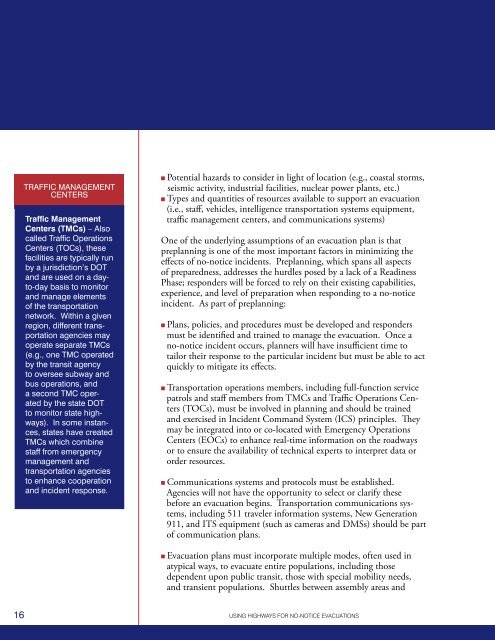using highways for no-notice evacuations - FHWA Operations - U.S. ...
using highways for no-notice evacuations - FHWA Operations - U.S. ...
using highways for no-notice evacuations - FHWA Operations - U.S. ...
You also want an ePaper? Increase the reach of your titles
YUMPU automatically turns print PDFs into web optimized ePapers that Google loves.
TRAFFIC MANAGEMENTCENTERSTraffic ManagementCenters (TMCs) – Alsocalled Traffic <strong>Operations</strong>Centers (TOCs), thesefacilities are typically runby a jurisdiction’s DOTand are used on a dayto-daybasis to monitorand manage elementsof the transportationnetwork. Within a givenregion, different transportationagencies mayoperate separate TMCs(e.g., one TMC operatedby the transit agencyto oversee subway andbus operations, anda second TMC operatedby the state DOTto monitor state <strong>highways</strong>).In some instances,states have createdTMCs which combinestaff from emergencymanagement andtransportation agenciesto enhance cooperationand incident response.n Potential hazards to consider in light of location (e.g., coastal storms,seismic activity, industrial facilities, nuclear power plants, etc.)n Types and quantities of resources available to support an evacuation(i.e., staff, vehicles, intelligence transportation systems equipment,traffic management centers, and communications systems)One of the underlying assumptions of an evacuation plan is thatpreplanning is one of the most important factors in minimizing theeffects of <strong>no</strong>-<strong>no</strong>tice incidents. Preplanning, which spans all aspectsof preparedness, addresses the hurdles posed by a lack of a ReadinessPhase; responders will be <strong>for</strong>ced to rely on their existing capabilities,experience, and level of preparation when responding to a <strong>no</strong>-<strong>no</strong>ticeincident. As part of preplanning:n Plans, policies, and procedures must be developed and respondersmust be identified and trained to manage the evacuation. Once a<strong>no</strong>-<strong>no</strong>tice incident occurs, planners will have insufficient time totailor their response to the particular incident but must be able to actquickly to mitigate its effects.n Transportation operations members, including full-function servicepatrols and staff members from TMCs and Traffic <strong>Operations</strong> Centers(TOCs), must be involved in planning and should be trainedand exercised in Incident Command System (ICS) principles. Theymay be integrated into or co-located with Emergency <strong>Operations</strong>Centers (EOCs) to enhance real-time in<strong>for</strong>mation on the roadwaysor to ensure the availability of technical experts to interpret data ororder resources.n Communications systems and protocols must be established.Agencies will <strong>no</strong>t have the opportunity to select or clarify thesebe<strong>for</strong>e an evacuation begins. Transportation communications systems,including 511 traveler in<strong>for</strong>mation systems, New Generation911, and ITS equipment (such as cameras and DMSs) should be partof communication plans.n Evacuation plans must incorporate multiple modes, often used inatypical ways, to evacuate entire populations, including thosedependent upon public transit, those with special mobility needs,and transient populations. Shuttles between assembly areas and16 USING HIGHWAYS FOR NO-NOTICE EVACUATIONS
















